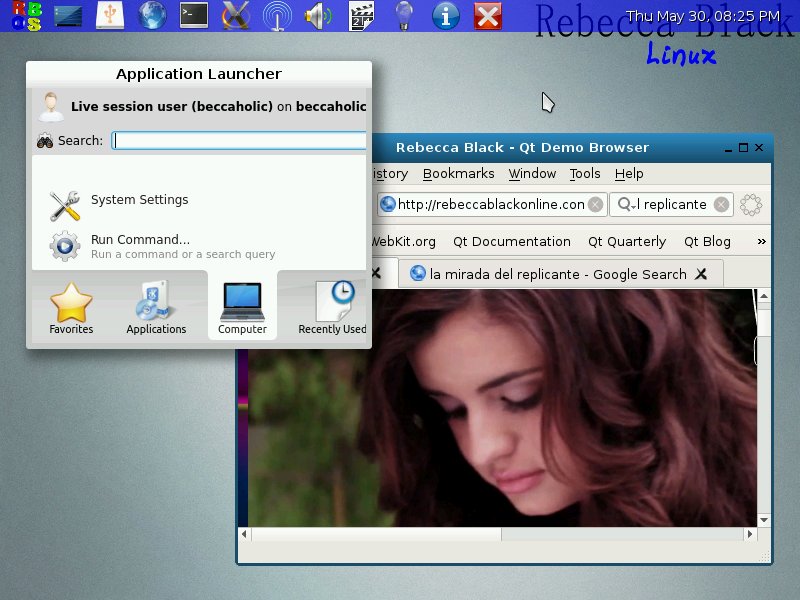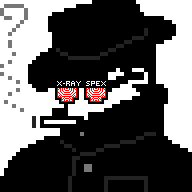I occasionally see love for niche small distros, instead of the major ones…
And it just seems to me like there’s more hurdles than help when it comes to adopting an OS whose users number in the hundreds or dozens. I can understand trying one for fun in a VM, but I prefer sticking to the bigger distros for my daily drivers since the they’ll support more software and not be reliant on upstream sources, and any bugs or other issues are more likely to be documented abd have workarounds/fixes.
So: What distro do you daily drive and why? What drove you to choose it?
I’m using RebeccaBlackOS because it finally utilizes Wayland’s capabilities fully.




Finally, an OS to rival HannahMontannaOS
It’s Thursday…what the hell are you doing!!! You’re going to break the Internet!!!
I would totally run RebeccaBlackOS or HannahMontannaOS in a vm
The distros are very different. HM is just Ubuntu with a theme.
RB is, to my knowledge, the only distro built around Weston, Wayland’s reference compositor. It doesn’t include any Rebecca Black theming, it’s just called that cause the distro’s maintainer is a fan of hers.
I shouldn’t talk because I dip in and out, but I do that because I like the possibilities. Like, what if someone comes up with a concept, but no one tries it, and it turns out to really work? Like, I like immutability as a concept, so I’ve tried Silverblue, Kinoite, and Bazzite. If nobody gave it a go, then the concept would die on the vine.
Also, I like seeing different ways of thinking about technology.
void boots fast on rather old or very low powered copmuters :3
Also on modern firebreathers.
I like runit better than systemd, the packages are current, and it has most of what I want in the main repos.
I also found the documentation excellent in thst it’s a cohesive list of real-world topics rather than a 500-km-deep wiki or forum archive.
I should try a modern Slackware one day. I loved it back before I had broadband and just ordered a burned CD for each new release, but I should try following -current and the Slackbuilds stuff.
Slackbuilds are really nice. Sbopkg lets you download queue files for each program, then automatically install necessary dependencies in the correct order, no matter if they’re available as packages or from source. Unfortunately, Slackware is so bare-bones out of the box that there are still pitfalls. For example, LibreOffice depends on avahi. And to successfully install that, you first need to create an avahi user and group, then install avahi, then write an init script that starts the avahi daemon and another one to stop it on shutdown.
-Current is much too active for my personal taste. I run Slackware because I’m a lazy Slacker.
The laziest approach to Slacking today is to install the default full install, then do:wget https://github.com/sbopkg/sbopkg/releases/download/0.38.2/sbopkg-0.38.2-noarch-1_wsr.tgz #Download the Slackbuilds helper Sbopkg slackpkg install sbopkg-0.38.2-noarch-1_wsr.tgz #Install it sbopkg -r #Sync its local repository to Slackbuilds sqg -a #Build queue files (dependency info) for the repository sbopkg -i flatpak #Install Flatpak and its dependencies flatpak remote-add --user flathub https://dl.flathub.org/repo/flathub.flatpakrepo #Add the Flathub repo
I really like immutable distros, and am currently using NixOS. I feel like despite still being relatively obscure, NixOS is a bit of an outlier since it has more packages than any other distro and is (so far) the only distro I’ve used that has never broken. There is a steep learning curve, and I certainly wouldn’t recommend it for non programmers, but it is something truly different than all mainstream Linux distros while being extremely reliable.
I use guix because, while it has a small community, the packaging language is one of the easiest I’ve ever used.
Every distro I’ve tried I’ve always run into having to wait on packages or support from someone else. The package transformation scheme like what nixos has is great but Nixlang sucks ass. Being able to do all that in lisp is much preferred.
Plus I like shepherd much more than any of the other process 0’s
I daily drive secureblue; or, to be more precise, its
bluefin-main-userns-hardenedimage.“Why?”, you ask. Because security is my number one priority.
I dismiss other often mentioned hardened systems for the following reasons:
- Qubes OS; my laptop doesn’t satisfy its hardware requirements. Otherwise, this would have been my daily driver.
- Kicksecure; primary reason would be how it’s dependent on backports for security updates.
- Tails; while excellent for protection against forensics, its security model is far from impressive otherwise. It’s not really meant as a daily driver for general use anyways.
- Spectrum OS; heavily inspired by Qubes OS and NixOS, which is a big W. Unfortunately, it’s not ready yet.
whonix?
Whonix is an OS exclusively meant to be used within a VM; at least, until Whonix-Host is released. Therefore, I didn’t include it as it’s not actually competing within the same space; as it can be run on any of the aforementioned systems within a VM. Finally, it’s worth noting that by its own documentation, it’s desirable to do so with Qubes OS.
Very interesting had not heard of this one yet. What are the main advantages of using this, that make it more secure?
What are the main advantages of using this, that make it more secure?
More secure compared to your average distro? Or more secure compared to a specific set of distros? Unless, this is properly specified, this comment could become very unwieldy 😅.
Thanks in advance for specifying!
Sorry, it was a badly formatted question I wrote whilst commuting earlier… I ended up looking the project up to look into the details, seems very promising! I’ll soon be booting Linux on a work laptop and think secureblue might be a very strong contender for this 💪
Debian, I got tired of things breaking in arch and even in fedora. I learned a lot but in the end, I just got tired of it.
I don’t get “distros”
I can customize my system to my liking. There some popular bases but that is it
I used to think that, too. But even Ubuntu and Debian are very different operating systems now.
On the other hand, it’s all Linux under the hood, and almost all computing tasks can be done on almost any distro.Finally, almost all distros exist because people choose to maintain them as a hobby without payment.
Who am I to judge whether they should pool their resources on fewer distros in their free time?
I drink and doomscroll in mine.
Because I’m a software luddite that believe we peaked in design at BSD/Plan9, and most of the “innovations” of enshittified corporate mainstream distros (redhat userland, atomic/immutable environments, “universal” (unless you’re not on linux) package management, containerization of anything and everything) don’t impress me, and more often than not turn me away. I’m not saying software can’t improve, but when it comes to mainstream linux (especially redhat), innovation is always 0 steps forward 40 convoluted leaps back with bonus windows compatibility.
reliant on upstream sources
Not relevant to independent distributions, which I’d actually consider more of a problem with popular distros very often being forks (most often of debian).
Just out of curiosity, what distro do you use?
Or maybe, despite the question, you use BSD? ( which is cool if so )
I use OpenBSD on my production machine and VPS, I use Alpine Linux on my phone. I’m also partial to Void Linux, though I don’t use it on any of my devices at the moment.
So which distro do you use? Plan9 was never completed I think?
Plan 9 is still actively developed in the form of 9front; updates and new features trickle down to 9legacy from there.
The “original” Plan 9—meaning stock 4th Edition—is more of a museum piece at this point, though, yes.
Oh boy, I know where I’m losing my next free weekend
I daily drive Slackware.
What drove me to it was curiosity. “How the fuck does a distro without dependency resolution even work? And why are people still using it?” As it turns out, it’s working very well actually. And I am now one of those people.
I like to tinker and solve puzzles. Installing the most old-fashioned distro on a modern convertible laptop, then bashing it till it looks and feels modern was a fun puzzle.
And it turned out to be a system I can daily drive on any device. Cause contrary to popular belief, you don’t need to hunt down dependencies manually every time you install something, that would be dumb. Once it’s set up, it’s actually very low maintenance and the knowledge I gained about its quirks will likely still be applicable in 10 years.What’s the Slackware way of managing package dependencies, then?
For Slackware itself, you install all available software up front. That way, all dependencies are resolved.
You then just hide the stuff you don’t need from your DE using its menu editor, or ignore it.
During an update, the package manager updates all installed packages, installs all packages that were added to the repo and removes all packages that are obsolete.For additional software, there is a semi-official repo that’s very similar to Arch’s AUR.
And like the AUR, it offers several helper scripts and additional package managers that do dependency resolution.
Or you use Flatpaks.you install all available software up front.
That’s unnecessary and inefficient, you can install a small subset and go from there.
I wouldn’t say it’s a full on daily, but Bunsenlabs distros. It started out with Lithium because they had a non PAE build and I needed it for an old Pentium M laptop. I ended up really liking it. It’s debian at the end of the day so software support is plentiful. It’s super lightweight. It ran on the pentium m laptop (only 1 gb of ram) without much issue. It’s also baby’s first foray into window managers as it used openbox.
I ended up installing it on my other old laptop that has an 8th gen i7. I’ve been pretty happy with it as a result.
I.have 2 gripes but idk if it’s Bunsenlabs’s fault. I had an nvme ssd that refused to play ball with it, a Samsung PM991A nvme ssd. I couldnt work with it at all. Using gparted to format it was a no go as Gparted would just die. I know that line of ssds is problematic in the hackintosh community. Not surprised that it sucks here. Also trying to disable the lid close is impossible. Tried cli, can’t find my lid close sensor. It might be because it’s a x360 laptop so it’s a lot more complex lid detection wise.
I had an nvme ssd that refused to play ball with it, a Samsung PM991A nvme ssd
Did other NVMe drives work? I wonder if it’s using an outdated NVMe driver… Was the kernel old?
I honestly haven’t tried any other nvme ssds with it because it’s such a pain to install new ones in that computer. It’s a motherboard removed procedure. I have an sn850x that Id want to try with it. It was on bookworm so an updated kernel.










